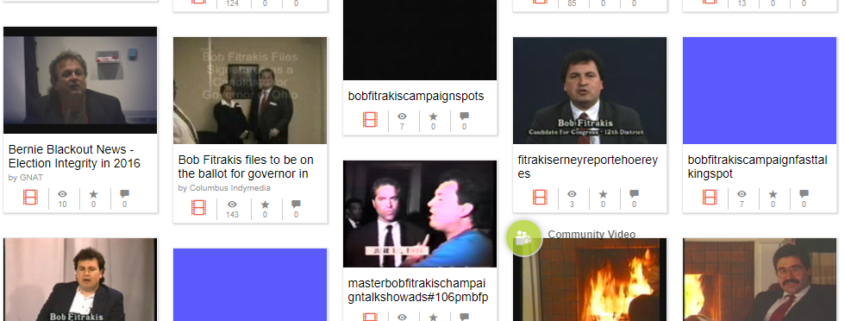Orig Published Columbus Alive 4-22-1999
4/22/1999
FEATURED ARTICLE
Spook Air
by Bob Fitrakis
Something’s rotten at Rickenbacker Port Authority. Maybe it’s just the stench of the bankrupt corpse of Southern Air Transport, or the moldering smell of the $3 million the state pumped into the notorious airline before it folded.
Ohio taxpayers are among the more than 800 creditors now lined up to file claims against “Spook Air.” SAT filed for bankruptcy in Columbus on October 1, 1998, the same day the Central Intelligence Agency Inspector General issued a report linking the cargo hauler to allegations of drug-running in connection with U.S.-backed Contra rebels in Nicaragua in the 1980s.
Once lauded as a coup for central Ohio development, landing Southern Air Transport’s business at Rickenbacker eventually turned into a nightmare, as the enterprise became mired in massive debt and was closed under a cloud of suspicion about its true activities. Just how and why one of the world’s most notorious airlines ended up in Columbus in the mid-1990s is a story that hasn’t been fully examined until now.
Through a Freedom of Information Act request, Columbus Alive obtained a massive number of documents from the Rickenbacker Port Authority and additional records from the Ohio Department of Development showing that the Franklin County Commissioners and the Voinovich administration offered hard-to-refuse incentives to get SAT’s business, despite the airline’s shady history.
“We are proud of Rickenbacker’s growth and believe the addition of Southern Air Transport would represent a significant step forward,” Franklin County Commissioner Arlene Shoemaker wrote Southern Air President William G. Langton in January 1995. SAT officials pitched a proposal involving the construction of a 180,000-square-foot corporate headquarters and air-maintenance facility on leased land in the Rickenbacker Air Industrial Park. They projected the total cost of the project at more than $36 million, and predicted the creation of 300 new jobs within a three-year period.
“I will need and look forward to help from the State of Ohio, the Port Authority, Franklin County, the City of Columbus, the Chamber of Commerce and any other groups or individuals you would suggest, to help effectuate a seamless move to Columbus, Ohio, and the Rickenbacker International Airport,” wrote Langton in a February 14, 1995, letter to the port authority’s Executive Director Bruce Miller. A “seamless move,” in Langton’s estimation, would cost $3 million.
The port authority and the Ohio Department of Development, under the aegis of Governor George Voinovich’s then-Chief of Staff Paul Mifsud, developed an attractive incentive package for SAT. The state development department agreed to provide SAT with a low-interest $6 million loan. The department promised an additional half-million dollars from a Business Development Capital Account to defray the cost of “eligible equipment associated with the project.” The Ohio Department of Transportation agreed to enter into a lease to support $10.2 million in Certificates of Participation to enable Rickenbacker to make “necessary taxi-way and parking improvements to allow SAT to locate in the park,” according to an SAT document. Such airport improvements are usually funded by the Federal Aviation Administration.
The document goes on to spell out that “the Rickenbacker Port Authority has committed approximately $600,000 to fund other public infrastructure improvements associated with the project… In addition, the port authority has also agreed to make available to SAT up to $30 million in port authority revenue bonds for eligible project related costs.” The SAT document noted that, “Franklin County has also committed to granting a 100 percent abatement for 15 years on real property improvements under Ohio’s Community Reinvestment Area Law.”
Shadowy ties to Ohio
News accounts show that The Limited owner Leslie Wexner played a role in SAT’s relocation to Rickenbacker. Two other key figures in the SAT story have Columbus connections: Alan D. Fiers Jr., a starting tackle on the 1961 Ohio State University football team and a Buckeye assistant coach in 1962, who later became the chief of the CIA Central American Task Force; and retired Air Force Major General Richard Secord, head of air logistics for the CIA-owned Air America’s covert action in Laos between 1966 and 1968, and air logistics coordinator in the illegal Contra resupply network for Oliver North in the ’80s.
Both Fiers and Secord eventually were found guilty of charges in connection with the Iran-Contra affair. On July 9, 1991, Fiers pleaded guilty to two misdemeanor charges involving illegally supplying weapons to the Contras. According to the recent CIA report on Southern Air Transport, Fiers informed U.S. Senate investigators that the CIA told the DEA early on about Contra leaders being involved in drug smuggling. Secord, who is a 1954 graduate of Columbus’ South High School, pleaded guilty in 1989 to a felony charge in connection with the cover-up of the Iran-Contra affair.
While SAT was busy setting up offices in central Ohio, the CIA was linking the airline to illicit activities. The October 1998 CIA report on Southern Air Transport says that as early as January 21, 1987, the customs office in New Orleans was investigating an allegation of drug trafficking by SAT crew members. The 1987 memorandum noted that the source of the allegation was a senior FDN (Contra) official, and indicated that the official was concerned that “scandal emanating from Southern Air Transport could rebound badly on FDN interest including humanitarian aid from the United States.”
The memo continues, “A February 23, 1991, DEA [Drug Enforcement Agency] cable to CIA linked SAT to drug trafficking. The cable reported that SAT was `of record’ in DEA’s database from January 1985-September 1990 for alleged involvement in cocaine trafficking. An August 1990 entry in DEA’s database reportedly alleged that $2 million was delivered to the firm’s business sites and several of the firm’s pilots and executives were suspected of smuggling `narcotics currency.'”
How did such a notorious company come to set up shop in central Ohio? Perhaps it was the efforts of Langton to keep the airline’s history in intelligence operations at arm’s length that assured Ohio officials of SAT’s success. In March 1995, Langton told the Columbus Dispatch that his company was “no longer connected to the CIA.”
“Too good to turn down”
It remains unclear exactly why Franklin County Commissioners were so willing to bring the scandal-ridden airline to central Ohio. Commissioner Dorothy Teater, currently running for mayor of Columbus, told Columbus Alive this month that she was not aware of Southern Air’s ties to the CIA. “If it’s true, that’s awful,” she said, adding the push to land SAT in Ohio came from the state Department of Development. “We commissioners were an afterthought. They asked us at the last second to sit in the audience at the press conference.”
When asked last week if she was aware of SAT’s past CIA links or allegations of drug running, Commissioner Shoemaker answered, “Certainly not.”
Documents obtained by Columbus Alive show that local officials did not balk at the notion of an enterprise at one time linked to drug smuggling and covert operations worldwide setting up shop here. They were apparently willing to overlook any danger signals in an effort to please local commercial enterprises that might benefit from SAT business. In 1996, SAT spokesperson David Sweet told Columbus Alive the airline moved to Ohio because “the deal [put together by the development department] was too good to turn down.”
The Franklin County Commissioners created the Rickenbacker Port Authority (RPA) in 1979 in order to utilize excess military land at Rickenbacker Air Force Base for industrial, distribution and air cargo purposes. In February 1992, the county commissioners created a Community Reinvestment Area for five years, making the Rickenbacker Port Authority a lucrative investment zone.
In a 1994 corporate report, which Columbus Alive retrieved from the Rickenbacker Port Authority’s files, Langton downplayed the airline’s controversial past and its crucial role in the Iran-Contra scandal, describing it as “an all-cargo airline operating schedule, charter and wetlease service for shippers, freight forwarders, the Department of Defense, relief organizations and individual customers around the world.”
On April 13, 1994, William B. Holley, executive vice president for economic development for the Columbus Chamber of Commerce, wrote the Ohio Job Creation Tax Credit Authority under the Ohio Department of Development, urging that the airline receive tax credits for relocating from Miami, Florida, to Rickenbacker International Airport in Columbus.
Edmund James, president of James and Donohew Development Services, told the Columbus Dispatch that negotiations with Southern Air had begun “exactly one year ago today,” speaking at the March 16, 1995, press conference announcing that SAT was locating to Columbus. He let it be known that “much of the Hong Kong-to-Rickenbacker cargo will be for The Limited.” James said, “This is a big story for central Ohio. It’s huge, actually.”
The day following the press conference, Brian Clancy, a cargo analyst with MergeGloban Inc., was quoted in the Journal of Commerce: “Limited Inc., the nation’s largest retailer, is based in Columbus, a fact that undoubtedly contributed in large part to Southern Air’s decision.”
That same day, the Dispatch noted a meeting between Langton, Governor Voinovich and “other officials yesterday to discuss the air cargo carrier’s plans.” Governor Voinovich is quoted saying, “This will be a new window to the world for Ohio business… It will be a boon for exports.” Within a week, SAT announced it would be flying twice-weekly freighters from Hong Kong to Columbus on behalf of The Limited.
In an article titled “Touchdown in Columbus,” SAT’s company newsletter featured an artist’s rendering of the proposed state-of-the-art headquarters on its cover and lauded “the very pro-business attitude of the State of Ohio and City of Columbus.”
That pro-business attitude is evident in a 1995 letter from SAT’s Langton to the Rickenbacker Port Authority. Although in response to Alive’s records request, former Governor Voinovich’s staffers claimed no records exist linking the governor or then-Chief of Staff Mifsud to the SAT deal, a February 22, 1995, letter from SAT chief Langton to Miller of the port authority stated: “I was very pleased with my visit with Mr. Paul Mifsud and Governor Voinovich, and after meeting with the State of Ohio it is my understanding that they will make the appropriate changes in funding amounts that we require in our Response to Proposal… I would expect to have a decision on the matter on or before March 10, 1995.” Numerous other SAT correspondence were carbon-copied to Mifsud at the governor’s office.
Repeated calls and a fax sent to Senator Voinovich’s office seeking comment for this article were not answered.
The next day, a letter from Ohio Department of Development Director Donald Jakeway to Langton begins, “Pursuant to your recent meeting with this department and Paul Mifsud, we are responding with this revised commitment letter…” Jakeway outlined a “revised preliminary commitment” worth an estimated $7.2 million in services, benefits, tax credits and low-interest infrastructure loans.
Jakeway is no longer with the Department of Development and was out of the country this week and could not be reached for comment. Calls to the Department of Development for comment were not returned by presstime.
On March 16, 1995, Langton joined then-Governor Voinovich and officials from the Rickenbacker Port Authority to announce officially the relocation of SAT from Miami to Columbus. In the Columbus Dispatch’s coverage of the announcement, an exuberant Voinovich gushed, “I am extremely pleased to welcome Southern Air Transport to Ohio, as it will be the first airline to have its world headquarters located at Rickenbacker Airport. This will help Columbus tremendously in becoming a world-class inland port.”
Shoemaker, representing the Franklin County Commissioners, said, “We’re deeply grateful to the governor and all those who helped make it possible to welcome Southern Air to Franklin County.”
Langton called Rickenbacker “an opportunity waiting to happen.”
By the end of the year, Langton was not sounding quite so positive. In the SAT newsletter, he stated: “As we close out 1995, I am sorry to report that we have the first loss year in recent history for Southern Air Transport.”
Spying the friendly skies
Apparently, the airline was in better shape financially when it was engaged in covert and possibly illegal activities. Officials of SAT, which was founded in 1947, acknowledge that their airline was owned by the CIA from 1960 to 1973. In 1960, the CIA purchased SAT for $300,000 and rapidly expanded the airline’s business into the Far East and Latin America. At one point, SAT was the CIA’s largest “proprietary”–a private business owned by the CIA–with estimated assets of more than $50 million and more than 8,000 employees worldwide.
In 1973, the CIA sold SAT to “the official who had run it on behalf of the CIA, with a $5.1 million loan from First National Bank of Chicago, known to be a CIA-used bank,” according to the National Journal. The airline retained informal ties with both the CIA and the National Security Council. The current principal owner is Miami attorney James Bastian, former CIA lawyer, who chaired the investment partnership of the management group that acquired SAT from the CIA. In 1979, Bastian acquired the company’s outstanding stock.
The airline’s activities after that suggest that it was still heavily tied to the U.S. national security apparatus. During the 1980s, Southern Air Transport carried a variety of military supplies, arms and equipment to the Contras. Southern Air President Langton admitted in an affidavit in the civil trial of SAT employee Eugene Hasenfus that SAT flew TOW anti-tank missiles from Kelly Air Force Base in San Antonio, Texas, to Israel. Southern Air crews then loaded the missiles onto Israeli-owned planes that flew them into Iran.
At the time, President Ronald Reagan was officially urging the world to embargo Iran, a country he called “Murder, Inc.” In 1986, SAT secretly shipped 90 tons of TOW missiles to Iran as part of the Reagan administration’s secret arms-for-hostages exchange. Proceeds from the sale of the missiles–some $16 million–were diverted to the Contra resupply effort in Central America. The scandal broke when on October 5, 1986, a Southern Air Transport C-123 cargo plane carrying 10,000 pounds of arms was shot down over Nicaragua.
The flight logs of the downed Southern Air Transport C-123 linked it to a history of involvement with the CIA, cocaine and the Medellin drug cartel in Colombia. The logs documented several Southern Air Transport flights to Barranquilla, Colombia, during October 1985, the same time Wanda Palacios, a Miami FBI informant, told the FBI that the airline was running drugs.
(It was also the same airplane that Louisiana drug dealer Barry Seal used in a joint CIA-DEA sting operation in 1984 against the Sandinistas. Seal acquired the plane through a complicated airline swap with the Medellin cartel, according to declassified government documents, and the plane was fitted with hidden cameras by the CIA at Rickenbacker Air Force Base. Seal reportedly flew weapons for the Contras and returned to the United States with cocaine. He was murdered in New Orleans in 1986 by Colombian hitmen.)
Reports of SAT involvement with drug runners surfaced early on in the Congressional Iran-Contra inquiry. In August 1987, the New York Times reported Palacios informed Congressional investigators that “she witnessed drugs being exchanged for guns intended for the Contras.” Palacios identified Southern Air Transport planes involved in the gun and drug running in two separate incidents in 1983 and 1985. Initially SAT denied any connection to the CIA and dismissed accusations of drug running as absurd.
Although SAT issued an internal memo denying any post-Iran-Contra connections to the CIA, during the Gulf War in 1990-91, Southern Air Transport played a key role in logistic support for the U.S. military. And in September 1990, the Air Force awarded SAT a $54 million contract for “air transport services.” Early 1996 opened for SAT with the same story line when it garnered a 90-day contract to transport construction supplies, equipment and civilian personnel from Zagreb, Croatia, to Tuzla, Bosnia, one of the world’s military hot spots.
The end of the runway
By the end of January 1996, company officials assured the Dispatch that SAT “isn’t backing away from the central Ohio hub,” but SAT officials were dragging their feet on plans to begin construction on a hangar at Rickenbacker.
SAT’s lack of action did not stop the state’s Controlling Board from approving, in May 1996, a half-million-dollar grant “related to the overall project of constructing a 180,000-square-foot facility.” Documents show that Doug Talbott of the Ohio Department of Development hand-carried a $500,000 check to an SAT official on August 5, 1996.
On December 19, 1996, the Dispatch reported that SAT was “delinquent in paying a $277,000 personal property tax bill.” SAT spokesperson David Sweet insisted that “the company is financially sound and intends to proceed with its Rickenbacker plans. `It’s not that we don’t have the money to pay the tax; we just dispute the amount,'” according to the Dispatch.
Langton, SAT’s president of 15 years, left abruptly in March 1997, handing the reins back to the airline’s owner James Bastian. Eight months later, SAT issued layoff notices to 100 of its 750 employees. Two months after that, Southern Air Transport publicly announced it would lay off 54 of the 65 maintenance workers at Rickenbacker and 43 of the 175 employees at the company’s temporary headquarters on Kimberly Parkway. Rickenbacker Port Authority now lacked any airport maintenance facility.
SAT, which had promised 300 new jobs within three years–and had already taken at least $3.5 million in state money–admitted that it hadn’t begun work on the maintenance facility project it had promised.
Marlo B. Tannous, deputy chief legal counsel for the Department of Development, issued a memo trying to figure out what “the exact job numbers” were submitted by SAT to the state. In June 1998, SAT announced it planned “to park and sell off most of its fleet of Lockheed Hercules L-100” planes.
That same month, Joseph C. Robertson, director of the state Department of Development, wrote J. Robert Peart, the executive vice president and CEO of SAT, inquiring about the $500,000 grant and an earlier $200,000 grant for new employee training. “It is critical that DOD receive an accurate assessment of your company’s situation related to these agreements,” Robertson wrote.
On July 30, 1998, Daniel F. Dooley, the chief financial officer of SAT, informed Lewie A. Main of the Department of Development that “Southern Air’s project will not proceed as planned at Rickenbacker due to severe financial difficulty.”
Fine Air Services of Miami announced a plan to purchase the financially troubled SAT on July 23, 1998. Robert Dahl, a consultant with Air Cargo Management Group, summed up SAT’s financial woes by pointing out “there are fewer belligerent circumstances in the world today than there were during the Cold War.” Apparently Spook Air needed the Soviets and the Red Menace to survive. Fine Air backed out of the agreement to purchase SAT “after getting a closer look at its books,” according to the Journal of Commerce.
Kitty Hawk Inc., the world’s largest operator of air cargo planes, signed a letter of intent shortly thereafter to buy SAT. Three weeks later, Kitty Hawk terminated the agreement. Neither Fine Air or Kitty Hawk gave reasons for their decisions not to purchase Southern Air.
Blanca Hernandez, a Southern Air spokesperson, denied rumors that the company was going to seek bankruptcy protection after the Kitty Hawk deal fell through. Three days later, Southern Air Transport grounded all its flights and fired 450 employees. Hernandez admitted that the company was “considering ways to liquidate assets.” The Dispatch reported that the Ohio Department of Transportation would not try to “recoup” $3 million it had loaned SAT.
Telephone calls to Southern Air Transport seeking comment for this story were referred to Columbus attorney Randy Latour. Citing pending litigation, Latour declined to comment.
The Dispatch managed to put a positive spin on the death of Spook Air: “But there were plenty of good times for Southern Air. Its Hercules fleet became the pack mules of the skies, transporting odd-size cargo, including Keiko, the whale, and taking part in humanitarian airlifts to Bosnia and Somalia.” Like local officials, the Dispatch ignored the mounting evidence of SAT’s ties to cocaine smuggling.
More recently, on April 4, the Dispatch reported that the airline’s already messy bankruptcy may be further complicated by allegations that $32 million in the private account of SAT owner Bastian’s wife Mary Bastian are company funds.
On October 1, 1998, the CIA Inspector General issued his report outlining allegations of Southern Air Transport’s involvement in drug-running. That same day, Spook Air filed for bankruptcy in Columbus.




